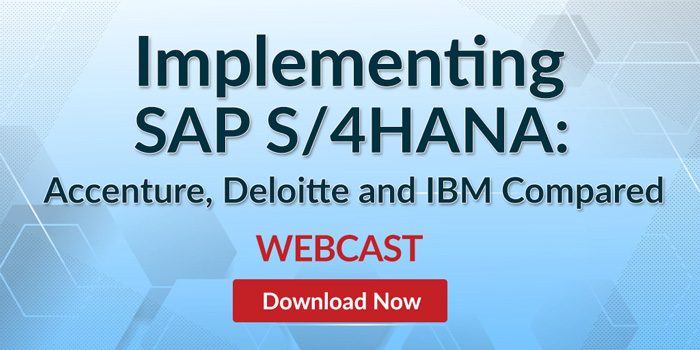- April 19, 2018
- John Belden
- Reading Time: 4 minutes

According to SAP, Cloud revenue will eclipse license fee revenue in 2018 and will become the largest base of their overall total. They’ve also stated that <20% of its customers have yet to migrate to their S/4HANA Cloud, so the opportunity is huge. They now have >1,500 live S/4 implementations, but likely half are net new customers. It is not clear of those 1,500 implementations what percentage are covering live customer operations vs. development implementations used for evaluation and testing. A question that many CIO’s are asking is, “When is the right time to make the move?”
Chief Collaborator
As competition increasingly comes from best-of-breed Cloud providers, SAP has bolstered their marketing strategy to increasingly include the CIO’s line of business counterparts including the CFO, CPO, CMO, and the COO. This not only puts the CIO in the role of Chief Technologist, but also Chief Collaborator. The CIO must now look to align the organization on a roadmap that delivers the biggest bang for the buck, based on a sequence of events moving from their established SAP platform to S4/HANA.
The Roadmap
A roadmap is basically a high-level plan that outlines the intended route or journey from the enterprise’s current state capabilities to some future or aspirational state. In the case of SAP, this means mapping a company’s current SAP Business Suite or ECC implementation to some future state of S/4HANA and all of its associated products. An effective roadmap is one that is embraced and understood by all C-levels and is practically actionable.
The Why, When, Where, How, Who, and What
When a plan is actionable, it answers the basic questions of why, when, where, how, who and what. Building this roadmap is oftentimes referred to as Phase 0. The following is a drill-down into each of these questions to highlight some specific important considerations.
Why?
Why are you undertaking this migration? What is the business case and the justification for S/4HANA? The business case is often identified as the key deliverable to launch any project and it provides the bedrock for future project decision-making. Without a rock-solid business case, there is a much higher probability that projects will crash and burn. You should ask yourself, “Has this business case provided us with a platform to make decisions throughout this journey?” Hershey recently announced they are making the move to S4/HANA and all eyes will be on their execution — and more importantly their results.
When?
Key questions are, “When should we start,” and “How long should it take?” Our assessment is that the longer a company waits, the more the migration will likely cost for two important reasons:
- At some point, there is going to be a wave or rush of activity to make the move to S/4HANA. When that happens:
- Resources are going to get scarce
- Scarce resources mean prices will increase
- Scarce resources also cause quality levels to drop
- Over time, the gap between the capabilities of the SAP Business Suite product and the S/4HANA platform will widen, making the cost of migration greater. SAP has stated that it does not intend to update legacy platforms at the same pace as they will for S/4HANA. This will create a capability gap that will need to be addressed at the time of transition.
Where?
The question arises of whether to go with the Public Cloud versus the Private Cloud, or to continue on-premise. Most of the activity has been on-premise or on the Private Cloud, but this will change over time as the Public Cloud solution becomes more mature.
SMB companies will likely be able to realize substantial value based on their ability to rapidly integrate and use a full SAP toolset suite of public tools. They can effectively leverage a first-mover strategy in the market, which will enable them to take advantage of the new capabilities that SAP will roll out.
How?
One strategy that is becoming more popular is an internal core simplification. This strategy involves moving capabilities historically found in the core SAP ECC / Business Suite out to the business network (e.g., Hybris, Ariba, Concur, or Fieldglass) with the intent to simplify the amount of dependence on core ERP.
This strategy actually reduces the expected cost of the move to SAP’s digital core due to the reduced scope and complexity that remain on the client’s legacy SAP platform. This also means they then can make the move to the S/4HANA platform at a lower cost in the future, lowering the mitigation capability gap risk.
Who?
With such an extensive amount of capabilities to implement and the lines blurring between the role of the software provider, the system integrator, and the traditional hosting and AMS providers, enterprises need to develop a sourcing strategy that will allow these vendors to compete for this business.
Enterprises are advised to look at the roadmap holistically and focus first on the skill sets the enterprise wants to keep in-house to develop a deep set of competencies to support the new implementation. Your in-house team competencies should include internal architects, technologists, project and program managers. Companies are also advised to build surge capacity on the legacy base to enable the support of the bubble of effort needed to facilitate the integration, conversions, data standardization, etc.
What?
What are you going to have to buy in the way of software or Cloud capabilities? SAP has made this a notoriously difficult process, and the propensity to redefine the product suites and sort through the toolsets and purchasing parameters, makes this a complex proposition at best, and a money trap at worst. Enterprises are advised to seek assistance beyond that of the SAP software salesperson in evaluating their current SAP contracts before requesting a quote from SAP.
The road to S4/HANA is one that is not likely to be straight and conducive to the use of cruise control. CIO’s need to be thoughtful in their planning and be willing to take detours as the SAP product line and potential business case evolves.
Comment below, follow me on Twitter @jmbelden98, find my other UpperEdge blogs, and follow UpperEdge on Twitter and LinkedIn.
Related Posts
- Implementing SAP S/4HANA Digital Core – Don’t Be a Prisoner to Unnecessary Costs
- Why De-coupling Your SAP and SI Partner Negotiations is a Bad Idea
- Considerations for Selecting an SAP System Integrator
- SAP’s Indirect Access Pricing for the Digital Age
- SAP and Indirect Use: Is SAP Taking Advantage of its Customers?
Related Blogs
5 Insights from SAP’s Q1 FY24 Earnings that Customers Should Pay Attention To
7 Key Risks to Consider When Evaluating RISE
Strategies for Holding Your ERP System Integrators Accountable
About the Author

